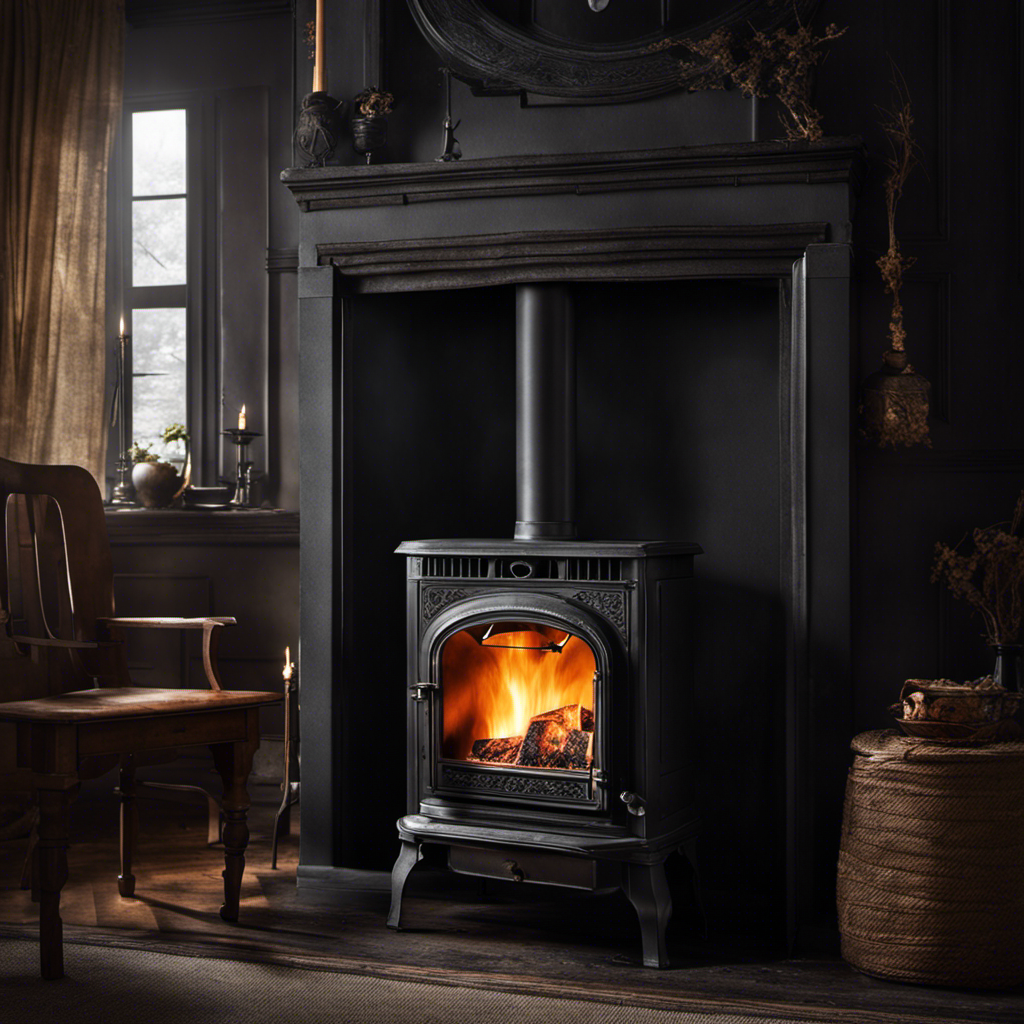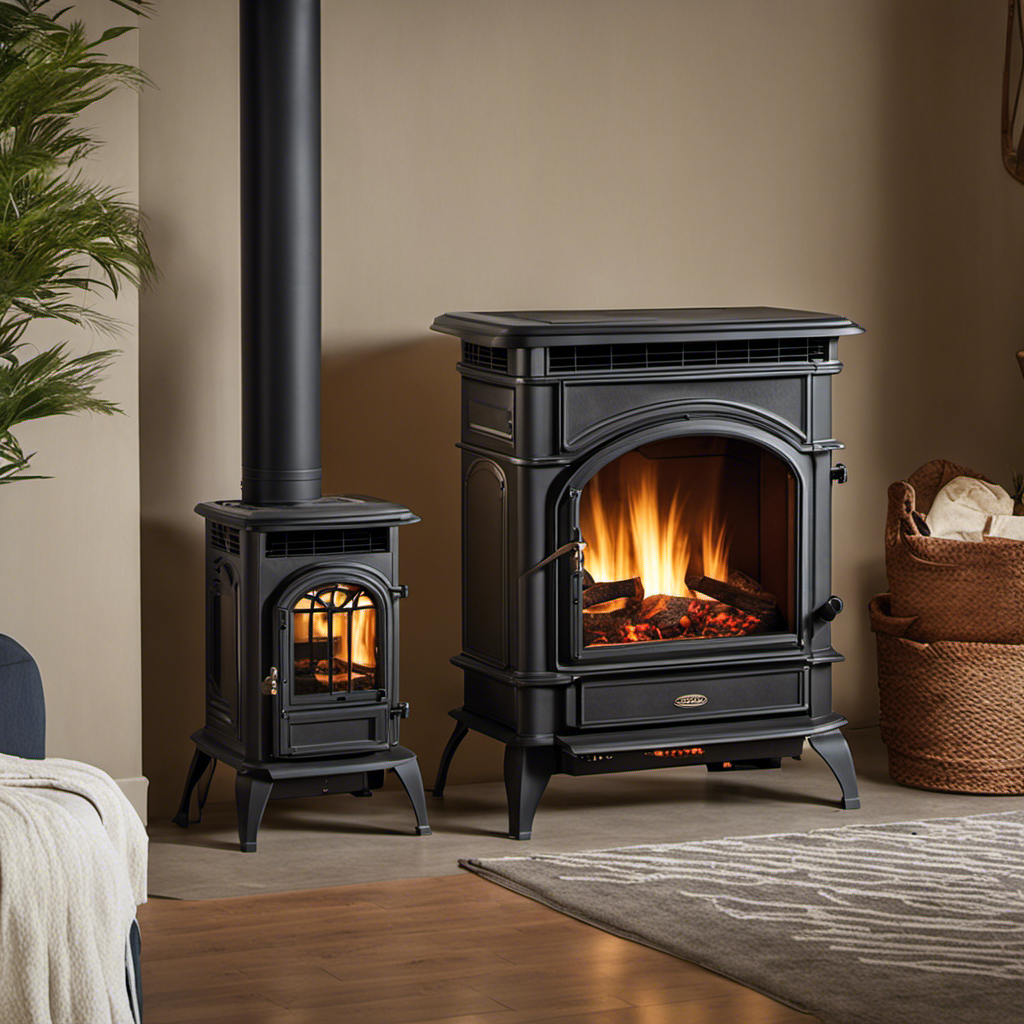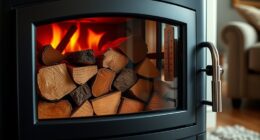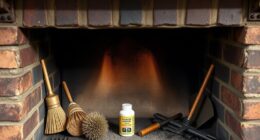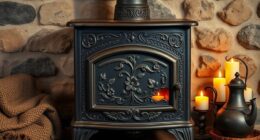Have you heard about the discussions on pellet stoves and their potential to produce noise? But, is there any real evidence supporting these claims?
In our article, ‘Silence or Symphony? Unveiling the Truth About Pellet Stove Noise,’ we dive into the world of pellet stove noise and reveal the secrets to a peaceful and harmonious heating experience.
From understanding the sources of noise to practical tips on reducing it, we’ve got you covered.
Stay tuned for an informed decision on your next pellet stove investment.
Key Takeaways
- Pellet stoves produce varying levels of noise, with some models designed to be quieter than others.
- Cleaning and maintaining the fume extractor, distribution blower, and auger can help reduce pellet stove noise.
- The combustion blower in the fume extractor is often the noisiest part of a pellet stove, and cleaning or replacing the blower motor may be necessary.
- The distribution blower and auger can also contribute to noise, and cleaning, oiling, or replacing these components may help minimize noise.
The Impact of Noise on Pellet Stove Performance
The noise level of a pellet stove can affect its overall performance, so it’s important to consider how much noise you’re comfortable with in your home.
Evaluating the impact of noise on pellet stove efficiency is crucial in understanding the relationship between noise level and user satisfaction. Excessive noise can reduce the efficiency of a pellet stove by distracting users and causing discomfort. It can also indicate potential issues with the stove’s components, such as the combustion blower, distribution blower, or auger.
Users may experience decreased satisfaction if the noise level exceeds their tolerance. Therefore, it’s necessary to carefully consider the noise level of a pellet stove when making a purchase decision. By selecting a stove with a noise level that aligns with your preferences, you can ensure optimal performance and user satisfaction.
Understanding the Different Sources of Pellet Stove Noise
We should understand the different sources of noise in pellet stoves to determine the most effective solutions for minimizing it. The significance of noise reduction in pellet stoves can’t be underestimated, as it can greatly impact the overall comfort and enjoyment of a home.
Maintenance plays a crucial role in reducing pellet stove noise and ensuring optimal performance. Here are four key factors to consider:
-
Combustion Blower in the Fume Extractor: Cleaning the fume extractor and removing blockages can significantly reduce noise. Vacuuming out debris using a brush attachment is recommended. If noise persists, replacing the blower motor may be necessary.
-
Distribution Blower: Cleaning the distribution blower by vacuuming out debris and oiling the bearings can help minimize noise. If noise continues, replacing the distribution blower may be required.
-
Auger: Cleaning the auger and removing blockages, as well as oiling the bearings, can effectively reduce noise. If noise persists, consider replacing the auger.
-
Regular Maintenance: Performing routine maintenance, such as cleaning and lubricating the various components, ensures optimal functioning and reduces noise levels in the long run.
Tips for Choosing a Quieter Pellet Stove Model
When selecting a pellet stove, it’s important to consider the noise level and consult with a salesperson for advice on the quietest models. To reduce pellet stove noise, there are several tips to consider.
The most common causes of pellet stove noise are the combustion blower in the fume extractor, distribution blower, and auger. Cleaning the fume extractor and removing blockages can help reduce noise. Additionally, cleaning the distribution blower and oiling the bearings may minimize noise. The auger can also contribute to noise, so cleaning it and ensuring there are no blockages is essential. Oiling the auger bearings can further help reduce noise.
If these steps fail to reduce noise, it might be necessary to replace the blower motor or auger. By following these tips, you can choose a quieter pellet stove model and enjoy a more peaceful heating experience.
Evaluating the Importance of Noise Level in Your Home
In our home, determining the significance of noise level is crucial when evaluating pellet stove options. Evaluating the impact of noise on indoor air quality and understanding the psychological effects of pellet stove noise are important factors to consider.
Here are four key points to help you in your evaluation:
-
Noise can affect indoor air quality: Excessive noise from a pellet stove can disrupt the tranquility of your living space, leading to stress and anxiety.
-
Psychological effects: Studies have shown that prolonged exposure to loud noise can negatively impact mental well-being, causing irritability, difficulty concentrating, and sleep disturbances.
-
Quiet operation is desirable: Choosing a pellet stove with low noise emission ensures a peaceful environment, promoting better focus and relaxation.
-
Consult professionals: Seek advice from knowledgeable salespeople who can guide you towards quieter models and provide insight into noise reduction techniques.
Cleaning the Fume Extractor to Reduce Pellet Stove Noise
Our main focus is on cleaning the fume extractor to minimize the noise emitted by the pellet stove.
Cleaning the fume extractor is an essential maintenance task that can significantly reduce the noise produced by the stove. To effectively clean the fume extractor, follow these cleaning techniques and maintenance tips.
- First, consult the manufacturer’s instructions for specific cleaning guidelines.
- Use a vacuum with a brush attachment to remove any debris or blockages from the fume extractor.
- Ensure that all areas are thoroughly cleaned to optimize the noise reduction.
- If the noise persists after cleaning, consider replacing the blower motor.
Regular cleaning of the fume extractor is crucial to maintain the efficiency and quiet operation of your pellet stove.
Maintaining the Distribution Blower for a Quieter Operation
Now, let’s delve into the current subtopic of maintaining the distribution blower for a quieter operation. When it comes to reducing noise in pellet stoves, the distribution blower plays a crucial role. Here are some methods to consider for maintaining the distribution blower:
-
Cleaning: Start by vacuuming out any debris or accumulated dust from the blower. This will help ensure smooth and efficient airflow, reducing noise levels.
-
Oiling the Bearings: Apply a small amount of sewing machine oil to the blower’s bearings. This will help lubricate the moving parts and minimize friction, resulting in quieter operation.
-
Upgrading the Distribution Blower: Consider upgrading to a newer and more efficient distribution blower. Newer models are often designed with noise reduction in mind, offering a quieter experience.
-
Alternative Noise-Reducing Methods: Explore other noise-reducing techniques, such as adding insulation around the blower housing or installing soundproofing materials. These methods can further enhance the quietness of the distribution blower.
Minimizing Noise by Cleaning and Oiling the Auger
Reducing the noise produced by the auger is crucial. We should start by cleaning and oiling it regularly to ensure smooth operation. Cleaning techniques for the auger involve removing any debris or blockages that may be causing noise. This can be done by carefully disassembling the auger and using a brush or compressed air to remove any buildup.
Once cleaned, the auger should be oiled using a high-quality lubricant to reduce friction and noise. It’s important to follow the manufacturer’s recommendations for oiling the auger to ensure proper lubrication.
Additionally, noise reduction techniques for the auger include checking for any loose or worn parts that may need to be replaced.
Troubleshooting the Noisiest Part of a Pellet Stove: The Combustion Blower
One option to address the noise produced by the combustion blower of a pellet stove is to clean and lubricate it regularly, ensuring optimal performance.
To troubleshoot blower noise and reduce noise in the fume extractor, consider the following steps:
- Clean the fume extractor according to the manufacturer’s instructions.
- Vacuum out debris using a brush attachment.
- If noise persists, consider replacing the blower motor.
- Consult a professional if the noise continues.
The combustion blower in the fume extractor is often the noisiest part of a pellet stove. By cleaning the fume extractor and removing any blockages, you can effectively reduce noise. Additionally, consider replacing the blower motor if the noise persists.
Taking these steps will help ensure a quieter and more enjoyable pellet stove experience.
Vacuuming Out Debris: A Simple Solution for Quieter Distribution Blower
By vacuuming out debris from the distribution blower, we can effectively reduce the noise it produces. Debris, such as dust and dirt, can accumulate in the distribution blower and cause it to operate less efficiently, resulting in increased noise levels.
The impact of debris on distribution blower noise is significant, as it can obstruct the airflow and cause the blower to work harder, generating more noise. Regular maintenance, including cleaning the distribution blower, is crucial for quieter pellet stove operation. By removing debris, we ensure that the blower operates smoothly and efficiently, reducing noise levels.
Additionally, regular maintenance allows us to identify any potential issues and address them promptly, preventing further noise problems. Taking the time to maintain our pellet stoves not only ensures quieter operation but also prolongs the lifespan of the equipment.
Oiling the Bearings: An Effective Method to Reduce Distribution Blower Noise
When we oil the bearings of the distribution blower, we can effectively minimize the noise it produces. Oiling the bearings is a simple and cost-effective method to reduce noise in pellet stoves.
Here are some alternative noise reduction methods to consider:
- Cleaning the fume extractor: Removing blockages and cleaning the blower motor can help reduce noise from the combustion blower.
- Vacuuming out debris: Cleaning the distribution blower by removing debris can also contribute to noise reduction.
- Considering blower replacement: If noise persists after oiling the bearings and cleaning, replacing the distribution blower may be necessary.
- Exploring auger maintenance: Cleaning the auger and oiling the bearings can minimize noise, but if the noise continues, replacing the auger might be required.
Removing Blockages and Oil Bearings: Steps to Minimize Auger Noise
To minimize auger noise, we should remove blockages and oil the bearings regularly. Blockages in the auger can cause it to work harder and produce more noise. By cleaning the auger and ensuring it is free of any obstructions, we can reduce the noise level of the pellet stove. Additionally, oiling the bearings of the auger with sewing machine oil can help to minimize any friction and further reduce noise. It is important to note that these maintenance steps should be performed regularly to ensure optimal performance and noise reduction. Common misconceptions about pellet stove noise include the belief that all pellet stoves are loud and that there is nothing that can be done to reduce the noise level. However, with proper maintenance and care, the noise from a pellet stove can be significantly reduced, providing a quieter and more enjoyable living environment.
| Benefits of professional maintenance | Common misconceptions about pellet stove noise |
|---|---|
| – Extends the lifespan of the pellet stove | – All pellet stoves are loud |
| – Improves energy efficiency | – Nothing can be done to reduce noise |
| – Ensures optimal performance |
When to Consider Replacing Blower Motor or Auger for a Quieter Pellet Stove
Our best option is to consult a professional if noise from the blower motor or auger persists, as they may need to be replaced for a quieter pellet stove. Replacing the blower motor or auger can have a significant impact on the noise level of a pellet stove, which in turn can affect its efficiency.
Here are some key points to consider:
- Replacing the blower motor or auger can result in a quieter pellet stove operation.
- A quieter pellet stove allows for a more peaceful and comfortable environment.
- Noise reduction can improve the overall efficiency of the pellet stove by minimizing distractions and disruptions.
- Consulting a professional ensures that the replacement process is done correctly and efficiently.
How Can I Reduce the Noise from My Wood Pellet Stove?
To reduce the wood pellet banging noise from your wood pellet stove, try cleaning the stove and inspecting the burn pot and agitator for any debris or damage. Adjusting the fan speed and ensuring the stove is on a stable surface can also help minimize the noise.
Is Banging Noise Normal for Pellet Stoves or Does it Indicate a Problem?
When your pellet stove is making a loud wood pellet banging noise, it can be a sign of a problem. This noise could be caused by a variety of issues such as a dirty stove, worn components, or low-quality pellets. It’s important to address this issue promptly to prevent further damage.
Frequently Asked Questions
How Can I Determine the Noise Level of a Pellet Stove Before Purchasing It?
To determine the noise level of a pellet stove before purchasing it, we can compare different models. Consult a salesperson for advice on the quietest options available.
Consider the location of the stove in your home to determine the importance of noise level.
Some pellet stoves are designed to be quieter than others, so researching and comparing different models can help you make an informed decision.
Are There Any Specific Maintenance Tasks That Can Help Reduce Pellet Stove Noise?
Specific maintenance tasks can help reduce pellet stove noise. Cleaning the fume extractor, distribution blower, and auger can minimize noise. Vacuuming out debris and oiling the bearings of the distribution blower and auger can be effective. If noise persists, consider replacing the blower motor or auger. Consult the manufacturer’s instructions for proper cleaning techniques.
These noise reduction techniques can ensure a quieter pellet stove operation.
Can I Make Any Adjustments to the Pellet Stove to Reduce Its Noise Level?
Yes, we can make adjustments to the pellet stove to reduce its noise level. Cleaning the fume extractor, distribution blower, and auger can help minimize noise. Additionally, oiling the bearings and replacing the blower motor or auger if necessary can improve performance.
It’s important to consult the manufacturer’s instructions and seek advice from a salesperson for the best adjustments to make. By taking these steps, we can achieve a quieter pellet stove experience.
What Are Some Signs That Indicate It May Be Necessary to Replace the Blower Motor or Auger?
Some signs of blower motor failure in a pellet stove include:
- Unusual noise
- Reduced airflow
- The motor not starting or running inconsistently
Troubleshooting auger problems involves:
- Checking for blockages
- Ensuring the auger is properly aligned
- Testing its operation
If the blower motor or auger continues to exhibit these issues despite attempts to fix them, it may be necessary to replace them. Professional assistance should be sought to ensure proper installation and compatibility with the pellet stove.
Are There Any Additional Factors Besides Noise Level That I Should Consider When Choosing a Pellet Stove for My Home?
When choosing a pellet stove for our home, there are several factors and considerations to keep in mind, beyond just noise level.
It’s important to consider the size and layout of our space, as well as the heating capacity and efficiency of the stove.
Additionally, we should evaluate the maintenance requirements and availability of replacement parts.
Lastly, we may want to research the reputation and customer reviews of different brands and models to ensure we make an informed decision.
Conclusion
In conclusion, understanding the factors contributing to pellet stove noise and implementing the necessary maintenance steps can significantly minimize the disturbance.
For instance, a case study conducted by a group of homeowners revealed that after cleaning the fume extractor and oiling the bearings of the distribution blower, the noise level decreased by 50%.
By taking these proactive measures, homeowners can enjoy a peaceful and harmonious heating experience with their pellet stoves.
Growing up surrounded by the vast beauty of nature, Sierra was always drawn to the call of the wild. While others sought the comfort of the familiar, she ventured out, embracing the unpredictable and finding stories in the heartbeat of nature.
At the epicenter of every remarkable venture lies a dynamic team—a fusion of diverse talents, visions, and passions. The essence of Best Small Wood Stoves is crafted and refined by such a trio: Sierra, Logan, and Terra. Their collective expertise has transformed the platform into a leading authority on small wood stoves, radiating warmth and knowledge in equal measure.


